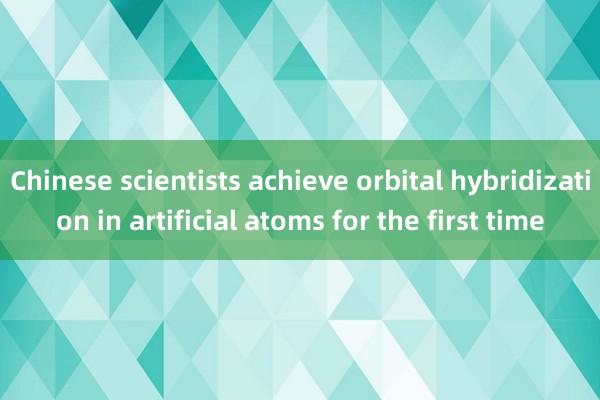
If the matter in nature is compared to a castle, then the atom is the "brick" that builds the castle, and the electronic orbit inside the atom is the "sound system" of the castle. However, scientists from various countries have never found the answer to how the "sound system" works for many years. What is exciting is that this problem that has long plagued the scientific community has been overcome by Chinese scientists. Sun Qingfeng's team at the School of Physics of Peking University recently cooperated with He Lin's team at the School of Physics and Astronomy of Beijing Normal University to publish a breakthrough result in the international academic journal "Nature": for the first time, they achieved orbital hybridization in artificial atoms, revealing the mystery of "atomic tuning" in the quantum world.
"Matter in nature is composed of atoms. When atoms combine to form matter, there are two important processes: one is the formation of chemical bonds between atoms, and the other is the orbital hybridization within atoms. Just like a well-trained band, different musicians not only have to play wonderful chords (chemical bonds) through cooperation, but each musician also has to tune and solo their instruments (orbital hybridization)." Sun Qingfeng told reporters that before, scientists from various countries have used artificial atoms to simulate the formation of chemical bonds between atoms, but the orbital hybridization within atoms cannot be successfully reproduced.
In response to this problem, Sun Qingfeng and his collaborators proposed a disruptive strategy, namely, to break symmetry by adjusting the shape of artificial atoms, and then achieve orbital hybridization within them. "Our research found that artificial atoms in graphene were pulled from a circle to an ellipse, and the relevant orbits would hybridize, forming a completely new electron state. Then, the team conducted research from the theoretical and experimental aspects, and the results confirmed each other and jointly realized the orbital hybridization of artificial atoms. If artificial atoms could only simulate 'ensemble' before, now we are like capturing the quantum notes of 'solo' for the first time," said Sun Qingfeng.
"This study also unexpectedly revealed the connection between two seemingly different physical phenomena - the new hybrid orbital includes both the 'echo wall state' and the 'atom collapse state'." Sun Qingfeng said that the echo wall is an acoustic phenomenon. For example, shouting next to the echo wall in the Temple of Heaven Park, the sound will propagate along the wall; and atom collapse is a prediction in quantum electrodynamics. When the atomic number is too large, atoms will become instable. "Although these two come from completely different research fields, they are wonderfully integrated in the process of orbit hybridization, just like reproducing the dialogue between architectural acoustics and nuclear physics at the quantum scale."
"This research fills the historical gap in the field of artificial atoms, provides a foundation for controlled research on orbit hybridization, and provides new ideas for the design of micro-nano structures in the future, provides a new regulatory dimension for the construction of smart materials and artificial matters, and has potential important application prospects in quantum computing." He Lin said, "Maybe one day, we can finely regulate the electronic orbits inside the material like tuners. It can not only 'chord' and 'solo', but also 'create musical scores' for electronic orbits, and thus bring more possibilities to the transformation and development of quantum technology."

